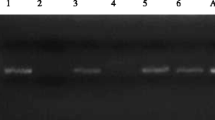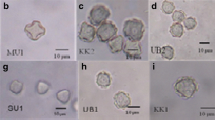Abstract
In order to detect the presence/absence of Acanthamoeba along with geographical variations, water quality variations and seasonal change of Acanthamoeba in Taiwan was investigated by 18S ribosomal RNA (rRNA) gene TaqMan quantitative real-time PCR. Samples were collected quarterly at 19 drinking water reservoir sites from November 2012 to August 2013. Acanthamoeba was detected in 39.5 % (30/76) of the water sample, and the detection rate was 63.2 % (12/19) from samples collected in autumn. The average concentration of Acanthamoeba was 3.59 × 104 copies/L. For geographic distribution, the detection rate for Acanthamoeba at the northern region was higher than the central and southern regions in all seasons. Results of Spearman rank test revealed that heterotrophic plate count (HPC) had a negative correlation (R = −0.502), while dissolved oxygen (DO) had a positive correlation (R = 0.463) in summer. Significant differences were found only between the presence/absence of Acanthamoeba and HPC in summer (Mann-Whitney U test, P < 0.05). T2 and T4 genotypes of Acanthamoeba were identified, and T4 was the most commonly identified Acanthamoeba genotypes. The presence of Acanthamoeba in reservoirs presented a potential public health threat and should be further examined.



Similar content being viewed by others
References
APHA (2005) Standard method for the examination of water and wastewater. APHA, WEF and AWWA, Washington, DC
Booton GC, Visvesvara GS, Byers TJ, Kelly DJ, Fuerst PA (2005) Identification and distribution of Acanthamoeba species genotypes associated with nonkeratitis infections. J Clin Microbiol 43:1689–1693
Bui XT, Winding A, Qvortrup K, Wolff A, Bang DD, Creuzenet C (2012) Survival of Campylobacter jejuni in co-culture with Acanthamoeba castellanii: role of amoeba-mediated depletion of dissolved oxygen. Environ Microbiol 14:2034–47
Carlson RE (1977) A trophic state index for lakes. ASLO 22:361–369
Corsaro D, Venditti D (2010) Phylogenetic evidence for a new genotype of Acanthamoeba (Amoebozoa, Acanthamoebida). Parasitol Res 107:233–238
da Rocha-Azevedo B, Tanowitz HB, Marciano-Cabral F (2009) Diagnosis of infections caused by pathogenic free-living amoebae. Interdiscip Perspect Infect Dis 2009:251406
Garcia A, Goni P, Cieloszyk J, Fernandez MT, Calvo-Begueria L, Rubio E, Fillat MF, Peleato ML, Clavel A (2013) Identification of free-living amoebae and amoeba-associated bacteria from reservoirs and water treatment plants by molecular techniques. Environ Sci Technol 47:3132–40
Gianinazzi C, Schild M, Zumkehr B, Wuthrich F, Nuesch I, Ryter R, Schurch N, Gottstein B, Muller N (2010) Screening of Swiss hot spring resorts for potentially pathogenic free-living amoebae. Exp Parasitol 126:45–53
Hewett MK, Robinson BS, Monis PT, Saint CP (2003) Identification of a new Acanthamoeba 18S rRNA gene sequence type, corresponding to the species Acanthamoeba jacobsi Sawyer, Nerad, and Visvesvara, 1992 (Lobosea: Acanthamoebidae). Acta Protozool 42:325–329
Hirst LW, Green WR, Merz W, Kaufmann C, Visvesvara GS, Jensen A, Howard M (1984) Management of Acanthamoeba keratitis: a case report and review of the literature. Ophthalmology 91:1105–1111
Hoffmann R, Michel R (2001) Distribution of free-living amoebae (FLA) during preparation and supply of drinking water. Int J Hyg Environ Health 203:215–219
Huang SW, Hsu BM (2010) Isolation and identification of Acanthamoeba from Taiwan spring recreation areas using culture enrichment combined with PCR. Acta Trop 115:282–287
John DT, Howard MJ (1995) Seasonal distribution of pathogenic free-living amebae in Oklahoma waters. Parasitol Res 81:193–201
Kao PM, Tung MC, Hsu BM, Tsai HL, She CY, Shen SM, Huang WC (2013a) Real-time PCR method for the detection and quantification of Acanthamoeba species in various types of water samples. Parasitol Res 112:1131–1136
Kao PM, Chou MY, Tao CW, Huang WC, Hsu BM, Shen SM, Fan CW, Chiu YC (2013b) Diversity and seasonal impact of Acanthamoeba species in a subtropical rivershed. BioMed Res Int 2013:405794
Kilvington S, White DG (1994) Acanthamoeba: biology, ecology and human disease. Rev Med Microbiol 5:12–20
Kyle DE, Noblet GP (1986) Seasonal distribution of thermotolerant free-living amoebae. I. Willard’s Pond. J Eukaryot Microbiol 33:422–434
Ledee DR, Iovieno A, Miller D, Mandal N, Diaz M, Fell J, Fini ME, Alfonso EC (2009) Molecular identification of T4 and T5 genotypes in isolates from Acanthamoeba keratitis patients. J Clin Microbiol 47:1485–1462
Liang SY, Ji DR, Hsia KT, Hung CC, Sheng WH, Hsu BM, Chen JS, Wu MH, Lai CH, Ji DD (2010) Isolation and identification of Acanthamoeba species related to amoebic encephalitis and nonpathogenic free-living amoeba species from the rice field. J Appl Microbiol 109:1422–1429
Maghsood AH, Sissons J, Rezaian M, Nolder D, Warhurst D, Khan NA (2005) Acanthamoeba genotype T4 from the UK and Iran and isolation of the T2 genotype from clinical isolates. J Med Microbiol 54:755–759
Martínez AJ (1985) Free-living amebas: natural history, prevention, diagnosis, pathology, and treatment of disease. CRC Press Inc
Martinez A, Visvesvara G (1997) Free-living, amphizoic and opportunistic amebas. Brain Pathol 7:583–598
Martínez A, Sotelo-Avila C, Garcia-Tamayo J, Morón J, Willaert E, Stamm W (1977) Meningoencephalitis due to Acanthamoeba sp. pathogenesis and clinico-pathological study. Acta Neuropathol 37:183–191
Nagington J, Watson P, Playfair T, McGill J, Jones B, Steele A (1974) Amoebic infection of the eye. Lancet 2:1537–1540
Nuprasert W, Putaporntip C, Pariyakanok L, Jongwutiwes S (2010) Identification of a novel T17 genotype of Acanthamoeba from environmental isolates and T10 genotype causing keratitis in Thailand. J Clin Microbiol 48:4636–4640
Page FC (1967) Re-definition of the genus Acanthamoeba with descriptions of three species. J Protozool 14:499–521
Page FC (1980) A light- and electron-microscopic comparison of limax and flabellate marine amoebae belonging to four genera. Protistologica 16:57–78
Qvarnstrom Y, Visvesvara GS, Sriram R, da Silva AJ (2006) Multiplex real-time PCR assay for simultaneous detection of Acanthamoeba spp., Balamuthia mandrillaris, and Naegleria fowleri. J Clin Microbiol 44:3589–3595
Ringsted J, Jager B, Suk D, Visvesvara G (1976) Probable Acanthamoeba meningoencephalitis in a Korean child. Am J Clin Pathol 66:723–730
Rodriguez Zaragoza S, Mayzlish E, Steinberger Y (2005) Seasonal changes in free-living amoeba species in the root canopy of Zygophyllum dumosum in the Negev Desert, Israel. Microb Ecol 49:134–41
Schroeder JM, Booton GC, Hay J, Niszl IA, Seal DV, Markus MB, Fuerst PA, Byers TJ (2001) Use of subgenic 18S ribosomal DNA PCR and sequencing for genus and genotype identification of Acanthamoebae from humans with keratitis and from sewage sludge. J Clin Microbiol 39:1903–11
Schuster FL, Visvesvara GS (2004) Free-living amoebae as opportunistic and non-opportunistic pathogens of humans and animals. Int J Parasitol 34:1001–1027
Seal DV, Kirkness CM, Bennet HGB, Peterson M, Group KS (1999) Acanthamoeba keratitis in Scotland: risk factors for contact lens wearers. Contact Lens Anterior Eye 22:58–68
Trabelsi H, Dendana F, Sellami A, Sellami H, Cheikhrouhou F, Neji S, Makni F, Ayadi A (2012) Pathogenic free-living amoebae. Epidemiol Clin Rev Pathol Biol 60:399–405
Visvesvara G, Schuster F (2008a) Opportunistic free-living amebae, Part I. Clin Microbiol Newsl 30:151–158
Visvesvara G, Schuster F (2008b) Opportunistic free-living amebae, Part II. Clin Microbiol Newsl 30:159–166
Walochnik J, Aichelburg A, Assadian O, Steuer A, Visvesvara G, Vetter N, Aspöck H (2008) Granulomatous amoebic encephalitis caused by Acanthamoeba amoebae of genotype T2 in a human immunodeficiency virus-negative patient. J Clin Microbiol 46:338–340
Warner BG, Asada T, Quinn NP (2007) Seasonal influences on the ecology of testate amoebae (Protozoa) in a small Sphagnum peatland in southern Ontario, Canada. Microb Ecol 54:91–100
Acknowledgments
This work was supported by a research grant from National Science Council of Taiwan, ROC (NSC 102-2116-M-194-006).
Author information
Authors and Affiliations
Corresponding author
Additional information
Responsible editor: Philippe Garrigues
Tsui-Kang Hsu and Po-Min Kao equally contributed to this work.
Rights and permissions
About this article
Cite this article
Kao, PM., Hsu, BM., Hsu, TK. et al. Seasonal distribution of potentially pathogenic Acanthamoeba species from drinking water reservoirs in Taiwan. Environ Sci Pollut Res 22, 3766–3773 (2015). https://doi.org/10.1007/s11356-014-3651-8
Received:
Accepted:
Published:
Issue Date:
DOI: https://doi.org/10.1007/s11356-014-3651-8




